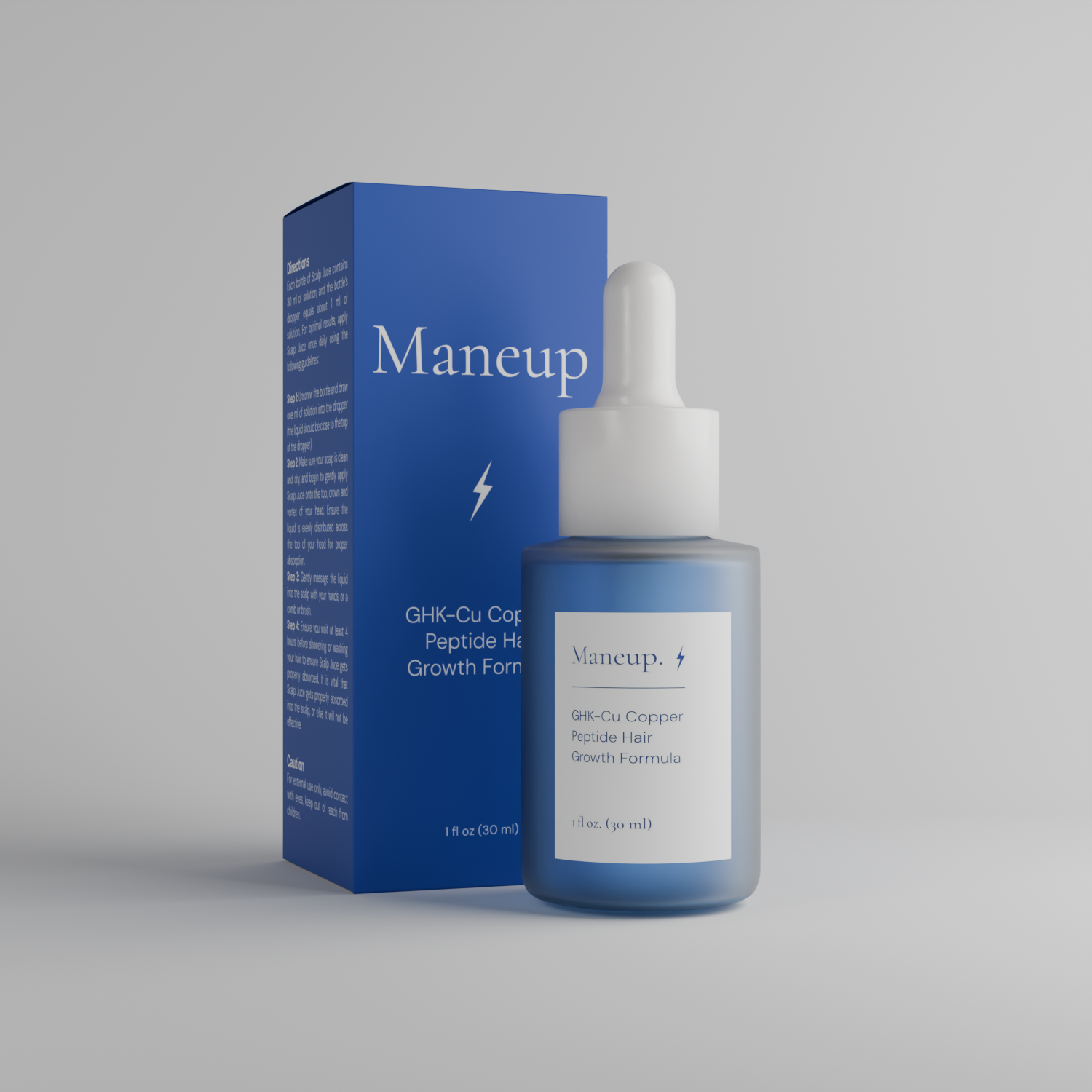Last updated: May 15, 2024
Minoxidil vs GHK-Cu Copper Peptide - Which Is Better?
Words by
Beowulf Urban

Share



Published on: May 15, 2024
Minoxidil, commercially known as Rogaine, stands out as a dominant player in the hair loss market, projected to reach a staggering $1.2 billion in revenue by 2024, following its $880 million earnings in 2017. While its exact mechanism of action remains elusive, several factors contribute to its purported effects.
Animal studies suggest that topical minoxidil accelerates the transition of hair follicles from the resting phase (telogen) to the active growth phase (anagen). This phenomenon likely mirrors its action in humans. Additionally, minoxidil may prolong the active growth phase and increase the size of hair follicles. Notably, orally administered minoxidil, through its sulphated metabolite minoxidil sulphate, lowers blood pressure by relaxing vascular smooth muscle via the opening of sarcolemmal KATP channels.
Featured Product
15% Off

Hair Restoration Serum | Advanced GHK-Cu Copper Peptide Formula
Use Code Blog15 For 15% Off
The enhancement of blood flow to the scalp is believed to underpin minoxidil's efficacy. Increased blood flow facilitates the delivery of essential nutrients and oxygen to the hair follicles, thereby promoting their growth. Research conducted at Massachusetts General Hospital (MGH) demonstrated that promoting blood vessel growth in the skin of mice led to faster and thicker hair growth, indicating the role of improved blood circulation in hair health.
However, despite its potential benefits, caution is warranted before starting minoxidil treatment. Continuous use is necessary to maintain results; discontinuation may result in the reversal of newly gained hair growth and continued hair loss. Some people may experience a major "shock loss" shed after discontinuing which results in more hair loss than before the user started. Moreover, minoxidil tends to be more effective in younger individuals with recent hair loss rather than those with long-standing baldness. Overall, its regrowth effects vary, with about 40% of men and 25% of women experiencing some degree of regrowth.
Critically, minoxidil, much like finasteride, is more of a "one hair loss pathway" fix. That pathway being lack of blood flow. Even with improved blood flow, underlying inflammation may persist, undermining its long-term efficacy. Some studies even suggest Minoxidils effectiveness may diminish over time. Furthermore, minoxidil is associated with common side effects such as scalp irritation, headache, nausea, heart palpitations and other heart issues, and fatigue, which may deter some users.
Although Minoxidil is a strong hair regrowth promoter and a powerful hair growth solution, compare it to GHK-Cu Copper Peptide and there are some obvious drawbacks.
To begin with, both compounds mechanism of action are similar. Most experts agree that the key to increasing hair growth lies in the blood vessel, both compounds do an excellent job at promoting blood flow on the scalp. In particular, multiple studies show GHK-Cu promotes angiogenesis, actually building new blood vessels, and increasing blood flow in existing blood vessels.
Although Minoxidil is a strong hair regrowth promoter and a powerful hair growth solution, compare it to GHK-Cu Copper Peptide and there are some obvious drawbacks.
To begin with, both compounds mechanism of action are similar. Most experts agree that the key to increasing hair growth lies in the blood vessel, both compounds do an excellent job at promoting blood flow on the scalp. In particular, multiple studies show GHK-Cu promotes angiogenesis, actually building new blood vessels, and increasing blood flow in existing blood vessels.
It also drastically reduces fibrinogen, which heavily influences the flow of blood through the microcirculation. GHK's ability to suppress Interleukin-6, a regulator of fibrinogen production, suggests its potential in reducing fibrinogen levels and mitigating CVD risk. Additionally, GHK downregulates the gene responsible for the beta chain of fibrinogen, further inhibiting fibrinogen synthesis.
Which compound is better at promoting scalp blood flow?
Thats hard to say without more controlled human studies examining both compounds, however GHK-Cu has the clear advantage of being able to actually create new blood vessels.
Where GHK-Cu really sets itself apart is its ability to combat chronic inflammation, cellular dysfunction, oxidative stress, and hypoxia.
Chronic inflammation: GHK-Cu possesses strong anti-inflammatory and anti-oxidant properties. Since we know that chronic inflammation can be a major cause and accelerant of hair loss, specifically alopecia areota, this is a biological factor that goes completely untreated with Minoxidil.
Animal experiments demonstrate that treatment with GHK leads to increased levels of antioxidant enzymes and possesses potent antioxidant and anti-inflammatory properties. GHK effectively neutralizes harmful free radical by-products of lipid peroxidation, such as 4-hydroxynoneal, acrolein, malondialdehyde, and glyoxal, thereby shielding skin keratinocytes from UV radiation damage. Notably, GHK significantly inhibits the Cu(2+)-dependent oxidation of low-density lipoproteins (LDL), offering superior protection compared to the widely used antioxidant superoxide dismutase (SOD1). Additionally, GHK binds to and prevents the damaging effects of lipid peroxidation by-products, including acrolein and 4-hydroxynonenal.
Moreover, GHK in the presence of copper (GHK:Cu(2+)) markedly reduces iron release from ferritin by 87%. Ferritin, found in blood plasma, can store significant amounts of iron, which serves as a catalyst for lipid peroxidation—a process that generates harmful free radicals, causing damage to DNA, proteins, and cell membranes. Dysregulation of iron metabolism contributes to various pathological conditions, including brain damage and neuron death in neurological disorders. When iron is released from ferritin, it forms a complex and initiates lipid oxidation chain reactions, further exacerbating cellular damage.
Cellular disfunction and cellular regeneration: We know that cellular disfunction in the form of cellular senescence is a huge underlying problem when it comes to hair loss. Healthy cells being stuck in "cell cycle arrest" which leads to a decline in their regenerative potential and tissue function. Furthermore it can lead to even more chronic inflammation and oxidative stress.
Early research suggests that GHK may serve as an early signal for skin repair, with its amino acid sequence present in type I collagen. Experiments indicate that GHK stimulates collagen synthesis, glycosaminoglycans production, and modulates the activity of enzymes involved in protein breakdown and their inhibitors, thus promoting skin regeneration.
Moreover, GHK exhibits positive effects on skin fibroblasts, crucial cells in skin regeneration, by increasing cell viability, growth factor production, and collagen synthesis when combined with LED irradiation. GHK-Cu specifically stimulates epidermal basal cells, enhancing their stemness and promoting skin renewal. These findings suggest GHK's potential in supporting skin health and appearance by promoting repair mechanisms and enhancing cellular functions critical for regeneration.
Oxidative stress and hypoxia: Oxidative stress, stemming from an imbalance between free radicals and antioxidants, can trigger hair loss by harming the scalp and hair. Free radicals, unstable molecules, can wreak havoc on cellular components like membranes, proteins, lipids, and DNA. Consequently, oxidative stress can hinder hair growth by damaging the scalp, weakening the anchoring force of hair strands within follicles, and ultimately leading to hair loss.
GHK-Cu plays a role in reducing oxidative damage by regulating iron levels. Iron complexes in damaged tissues hinder wound healing by promoting lipid peroxidation and microbial infections. Research shows that GHK-Cu inhibits lipid peroxidation when ferritin is the iron source. This is achieved by GHK-Cu binding to ferritin channels involved in iron release, thereby preventing the release of Fe(II). Consequently, GHK-Cu acts as an antioxidant in wounds by inhibiting ferritin iron release, which helps prevent inflammation and microbial infections.
Hypoxia is also a major concern for hair and hair loss, Hypoxia is a state in which oxygen is not available in sufficient amounts at the tissue level to maintain adequate homeostasis; this can result from inadequate oxygen delivery to the tissues either due to low blood supply or low oxygen content in the blood (hypoxemia).
GHK-Cu combats hypoxia in the scalp by not only promoting blood flow, but opening up the hair follicle through cellular regeneration and increased blood flow, in turn allowing for higher nutrient partitioning and increased oxygen absorption.
Of course everyone knows that DHT plays a huge role in hair loss and is often believed to be the "only" contributing factor to hair loss. While this is a very one dimensional view of the hair loss equation, it still plays a massive role. Both GHK-Cu and Minoxidil users will still need to get DHT under control, however by increasing blood flow on the scalp, the hair follicles sensitivity to DHT is diminished.
GHK-Cu simply stands out from Minoxidil due to the fact that it is more angiogenic, and has the ability to actually create new blood vessels. And of course, its ability to clean up chronic inflammation, oxidative stress, cellular senescence, and hypoxia make it one of a kind. Perhaps the most compelling reason GHK-Cu stands out from Minoxidil is its ability to create the same outcomes as Minoxidil but without the risk of side effects.(5).
Bibliography
PubMed. "Copper peptide GHK-Cu and hair growth." PubMed, National Center for Biotechnology Information, 1 Mar. 2004, https://pubmed.ncbi.nlm.nih.gov/14996087/.
ScienceDaily. "Copper Peptide GHK-Cu Improves Hair Transplant Success." ScienceDaily, ScienceDaily, 15 Feb. 2001, https://www.sciencedaily.com/releases/2001/02/010215074636.htm.
Roman. "Does Minoxidil Work for Hair Loss? What the Science Says." Roman, Roman Health Ventures Inc., https://ro.co/hair-loss/does-minoxidil-work/.
Mayo Clinic. "Minoxidil (Topical Route) Side Effects." Mayo Clinic, Mayo Foundation for Medical Education and Research, https://www.mayoclinic.org/drugs-supplements/minoxidil-topical-route/side-effects/drg-20068750?p=1.
National Center for Biotechnology Information. "Contribution of the GHK-Cu Complex to Regulation of Stemness and Stem Cell Activity." National Center for Biotechnology Information, U.S. National Library of Medicine, 10 June 2020, https://www.ncbi.nlm.nih.gov/pmc/articles/PMC10643103/
Harvard Health Publishing. "Hair Loss: A to Z." Harvard Health Publishing, Harvard Medical School, https://www.health.harvard.edu/a_to_z/hair-loss-a-to-z.
Upton, Dylan. "Premature hair loss in men and women: What can be done?" National Center for Biotechnology Information, U.S. National Library of Medicine, 17 July 2018, https://www.ncbi.nlm.nih.gov/pmc/articles/PMC6073405/.
National Center for Biotechnology Information. "Premature hair loss in men and women: What can be done?" National Center for Biotechnology Information, U.S. National Library of Medicine, 17 July 2018, https://www.ncbi.nlm.nih.gov/pmc/articles/PMC6073405/
Featured Product
15% Off

Hair Restoration Serum | Advanced GHK-Cu Copper Peptide Formula
Use Code Blog15 For 15% Off















